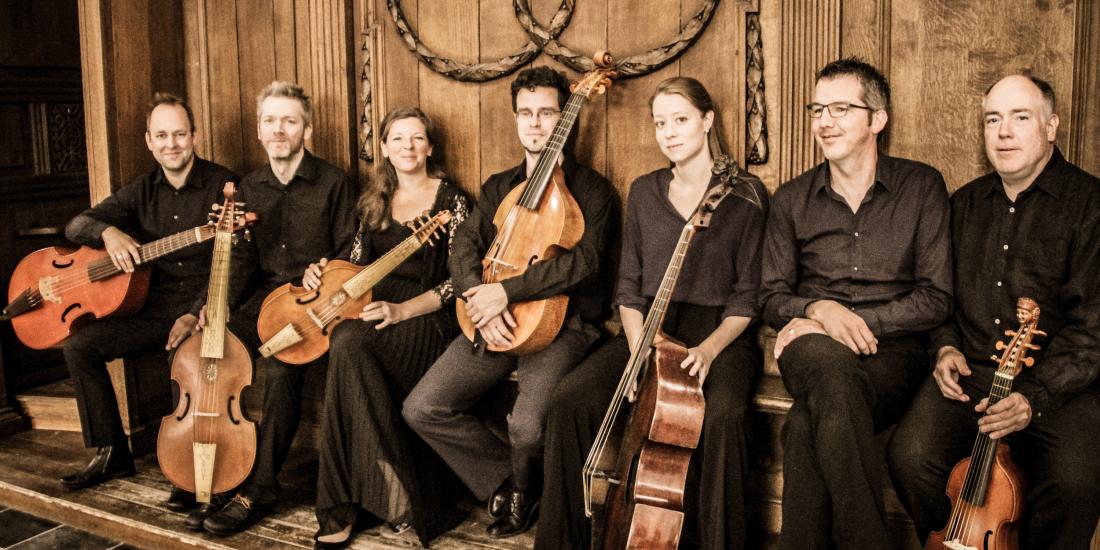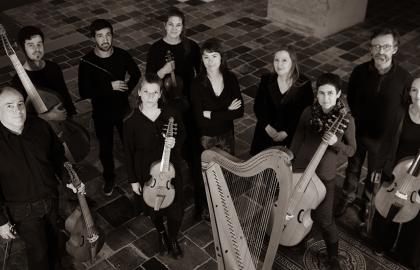For more than a decade, Hathor Consort has been building an artistic path bridged by numerous collaborations. Their first project LACHRIMAE with Femke Gyselinck was a crossover between contemporary dance and the 17th-century songs of John Dowland. Now a new dance project is added: Bach's the Kunst der Fuge. This "milestone of counterpoint" illustrates Bach's universality, across genres, says gambist Romina Lischka. Together with dancers Jason Respilieux and Frank Gizycki, she explains:
The Kunst der Fuge is considered by some to be a theoretical work. Despite these opinions, what emotional layering do you find in the work?
Lischka: I was wondering at the beginning: what can you do on the Kunst der Fuge, a work that is such a universal, golden-ratio, perfect thing. Thanks to the addition of dance, the emotional layer becomes clearer in the music. I can see more of what I hear and feel. I find it very spiritual. Logically, spirituality must have been very present around the work of Bach at the time.
Let’s talk about some of the mysteries surrounding the Kunst der Fuge. You won’t play the piece on a key instrument but as a group of four viola da gambas. Is it an easy translation to your instrumentation?
Lischka: You don’t have to arrange it. You play what is written. But it remains Bach, so it’s never easy. You must work for it. Some parts are idiomatic for the instrument, others are not. And even if the writing is natural for the instrument, you must remember the chamber music aspect: how to say the same thing? Which message do you want to transmit? How do you relate the musical lines to each other? There’s a certain complexity in the music. But after all the hard work, you arrive in a certain sphere where special things happen!
In performing Bach there are always so many possibilities, depending on the sources. In bowings for example. But sometimes the process of going through the possibilities is more important than the final decision. Bach always sounds good, no matter how you play it. The music is so good. There’s not one clear answer on ‘the’ way of performing Bach.
One of the possibilities is to puzzle with the order of the fugues. Which chronology will you follow?
Lischka: We made a change in the ‘usual’ order to make the piece a bit lighter, in a way. There’s no increase of complexity anymore – from simple fugues to canons - but an alternation. So, it comes from a more emotional choice. I wanted to have more ‘air’ in the work.
And what about the ‘unfinished’ last fugue?
Lischka: We won’t be playing the complete work. We leave the work unfinished and don’t attempt to complete it ourselves. Again, it’s just one of the possibilities we went for.
The Kunst der Fuge is a highly structured piece, based on a basic motif worked out in many ways. How do you approach the piece as a choreographer? Does the structure of the composition act as a starting point?
Respilieux: We don’t transform a motif in a literal sense, but we do use transformation as a principle in the way we relate to our material, as a principle to play around with. Our approach is much more based on improvisation. We didn’t want to use the structure of the music or apply mathematical rigour. We wanted to create a contrast, to enlighten those musical structures by laying bare an emotional line and create a counterpoint to the music, not a parallel.
So the notion of counterpoint was conceived as a dance term too?
Respilieux: We’ve worked on the music of Bach before with other companies, with a very specific style that was much more mathematical, much more contrapuntal in a very strict way. Here it is less strict. Counterpoint is seen more as a dramaturgy in itself.
Gizycki: Counterpoint of one thing in relationship to another thing. And how within that, there is tension or not, and how that informs the one or the other.
Respilieux: Dance is clearly not the same medium as music, so the question was how dance can actually intensify your experience of this music. The goal was to keep it a concert. We didn’t want the dance to impose a certain interpretation on the piece.
How was this worked out concretely?
Lischka: Jason and Frank always showed me the material that they were working on. And then we would talk about it. It was a conversation about my perception of certain things that I felt were strengthening the whole perception of the music.
Respilieux: Exactly: What do you hear? What do you feel?
Gizycki: I remember Romina saying “I see that Jason is playing more with the verticality and being more fluid, while Frank is more grounded and pragmatic with the hands. What does it say?”.
Lischka: We talked about the possibility of the subject and countersubject. But in the end, it also turned into a more universal question about humanity and God and how both are represented. So, the conversations went to being about the character of the music.
Respilieux: It was like a flux of information, of different interpretations, or different ways of relating to this music. And these discussions were really the nourishment, the food to keep digging into what these feelings are about. There was a lot of talk back and forth about worldviews. I strongly feel that three brains and three bodies blended into one for this performance. It’s situated in between of the visions that we have about this music.
What would be your vision about this piece? Bach keeps inspiring choreographies. How does the music affect you?
Gizycki: We were reflecting about this together. And we felt the material also brought us together in a different way than how we used to collaborate. The question of man and God really came from the question of intimacy in a way. What is intimate? We related very strongly to a quote we read together in an essay by François Jullien. He says that what is the most interior, what is the most deep inside of you, is actually calling from the outmost exterior. You can be intimate with yourself, but you can be even more intimate with someone else. You need the other one, to actually be able to reveal what’s most intimate. Somehow the notion that something which is very close to us is also connected with the infinite, really echoed a lot with the music.
Only with Bach does a universal story feel so intimate. Moreover, the mysteries surrounding the Kunst der Fuge allow for a plethora of personal choices. Romina Lischka, Jason Respilieux and Frank Gizycki clearly did not miss that opportunity. Enjoy the performance.

